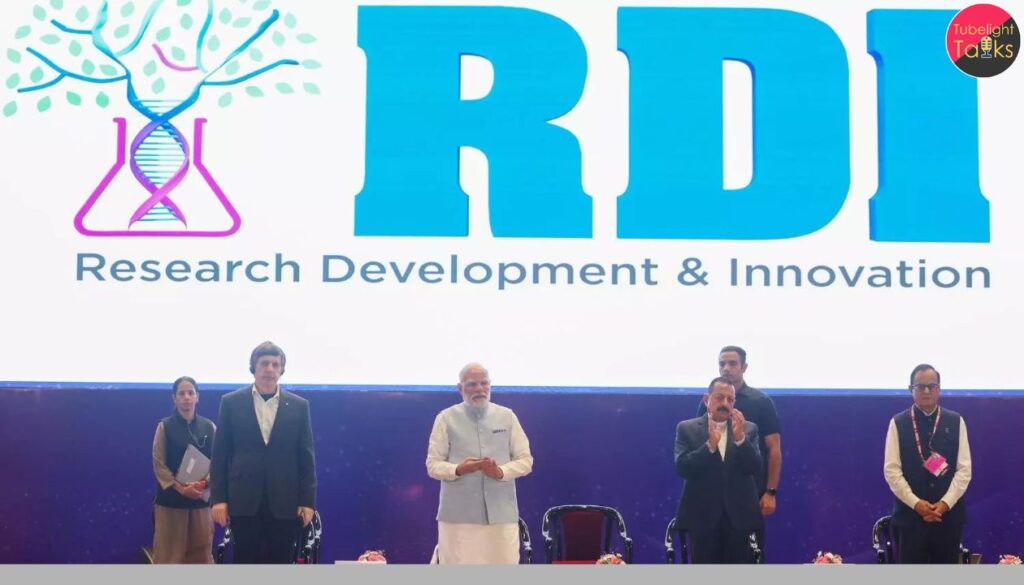RDI Fund Explained: India has formally launched the ₹1 lakh crore Research, Development & Innovation (RDI) Fund to catalyse private investment in transformative technologies. Announced at the Emerging Science, Technology & Innovation Conclave (ESTIC) in New Delhi on November 3, 2025, the scheme builds on Cabinet approval from July 1, 2025 and the Budget 2024–25 corpus announcement of a 50-year interest-free loan to seed long-tenor, low/zero-interest RDI finance.
The fund is structured with a Special Purpose Fund (SPF) under ANRF and second-level fund managers (AIFs, DFIs, NBFCs, FROs). Here’s the complete playbook: sectors, financing terms, guardrails, and immediate actions for industry and startups.
What exactly launched – and why it matters now
The government has launched the RDI Scheme and Fund to address a chronic gap: patient, affordable capital for high-risk, high-impact research in the private sector. The Prime Minister, speaking at ESTIC 2025, emphasised that—for the first time—capital is being made available for high-risk, high-impact projects at meaningful scale. The scheme aims to spur private investment, commercialise research, and strengthen strategic and sunrise sectors critical to India’s economic security and technological self-reliance.
PM at ESTIC 2025: capital will be available for high-risk and high-impact projects under the ₹1 lakh crore RDI Scheme.
The money path: a two-tier funding architecture
Tier 1 (Custodian): A Special Purpose Fund (SPF) is set up under the Anusandhan National Research Foundation (ANRF) to hold and steward the corpus. Tier 2 (Implementers): The SPF channels capital to Second-Level Fund Managers (SLFMs)—a mix of AIFs, DFIs, NBFCs, and Focused Research Organisations (e.g., BIRAC, TDB, IIT Research Parks)—which then finance eligible RDI projects at arm’s length through expert investment committees.
This model solves two problems at once: it keeps the corpus professionally managed and market-aligned, while ensuring deployment via specialised vehicles that understand TRLs, deep-tech risk, and commercialisation pathways. In other words, it’s built to be fast, expert-led, and insulated from day-to-day administrative bottlenecks.
The financing logic: long tenors, low/zero interest, patient risk capital
Budget 2024–25 first proposed a ₹1 lakh crore corpus capitalised through a 50-year interest-free loan to enable long-term financing or refinancing at low or nil interest rates. The Cabinet’s July 1 approval affirmed this approach; the final guidelines maintain the emphasis on patient capital and growth/risk financing targeted at private-sector RDI. Expect instruments like concessional loans, convertibles, and co-investment with private capital to crowd in industry skin-in-the-game.
Who can get funded—and for what kinds of projects
While the SPF doesn’t fund companies directly, SLFMs will finance industry RDI projects with transformative potential at higher TRLs (≈TRL-4 and above)—where prototypes, pilots, and scaling need serious money. Priority is on projects that de-risk key technologies, accelerate commercialisation, and reduce import dependencies in identified sectors.
Government entities and next-gen R&D lab construction are explicitly not the focus; the scheme is designed for private-sector RDI, with up to ~50% of project cost typically financed by the scheme, and the rest by proponents.
What are “sunrise and strategic sectors” under RDI?
Official briefings and FAQs list energy security and climate action, semiconductors, quantum technologies, AI, biotechnology, and wider digital-economy domains among the targets, with flexibility to add areas aligned to national priorities—think space technologies, advanced materials, robotics, battery and storage, next-gen communications, and secure systems. The list is indicative and will evolve through ANRF and DST governance.
The governance stack: how decisions get made
Under ANRF’s oversight, the SPF allocates capital to vetted SLFMs. Each SLFM forms an independent investment committee with financial, business, and technical experts; proposals are screened for technology merit, commercial traction, strategic relevance, and scalability. The arm’s-length principle is deliberate: it reduces conflicts, normalises market discipline, and accelerates time-to-money for qualified projects.
Guardrails and exclusions (so you don’t waste time)
Guideline highlights include: (1) No direct SPF-to-startup investing—apply via SLFMs; (2) Focus on TRL-4+ work (prototype/pilot/scale) rather than basic science; (3) Avoid overlap with ANRF’s grant-led mandate; (4) No short-term working-capital loans; (5) Funding caps—the scheme typically supports up to ~50% of assessed project cost, requiring promoter and private co-funding. These rules concentrate scarce public capital where it crowds in private money and pulls technology to market.
Timeline: from Budget promise to launch

- Feb 1, 2024: Finance Minister proposes a ₹1 lakh crore corpus with a 50-year interest-free loan to seed long-tenor, low/zero-interest RDI finance.
- Jul 1, 2025: Union Cabinet approves the RDI Scheme, confirming corpus and two-tier architecture.
- Oct 2025: ANRF Executive Council clears key operational decisions, including channelising funds via AIFs/DFIs/NBFCs/FROs.
- Nov 3, 2025: Launch at ESTIC 2025 in New Delhi; PM highlights high-risk, high-impact project focus. A detailed PIB explainer and PDF are published the same week.
How the ₹1 lakh crore may be apportioned (indicative lenses)
The government has not published a rigid sector-wise split; allocations will flow dynamically via SLFMs, based on deal flow, readiness, and national priorities. That said, official notes and DST pages point to deep-tech concentrations. Here are utilisation lenses—how money could line up with policy goals:
Strategic tech & economic security
- Semiconductors & advanced packaging: process innovation, yield improvement, and equipment localisation (metrology, specialty gases/chemicals).
- Secure & trusted systems: cybersecurity, indigenous cryptography, secure silicon, resilient supply chains.
- Dual-use deep-tech: autonomy, advanced sensors, and precision manufacturing lines.
These areas appear repeatedly across RDI descriptions as “strategic and sunrise.” Expect SLFM-led vehicles to prefer co-investment alongside private fabs, design houses, and equipment vendors. (Scope inferred from “strategic/sunrise” framing and DST/PIB cues.)
Climate action & energy security
- Battery tech & BMS, sodium-ion, solid-state prototypes;
- Green hydrogen components (electrolysers, membranes, BoP), fuel cells;
- Grid-scale storage, power electronics, and high-efficiency inverters;
- Industrial decarbonisation pilots (cement/steel process innovation).
These map to the explicit energy security and climate action thrusts in RDI narratives.
AI, quantum & next-gen computing
- AI for manufacturing, drug discovery, agri-yield optimisation;
- Edge AI hardware, neuromorphic prototypes;
- Quantum sensors/communications and error-mitigation pilots.
Expect SLFMs to evaluate TRL, IP strategy, and path to revenue carefully here.
Bio-innovation & health tech
- Biomanufacturing (enzymes, biologics), vaccines and platform technologies, diagnostics;
- Med-devices (implants, imaging, robotics) with strong regulatory roadmaps.
Focused Research Organisations like BIRAC and TDB may feature as SLFMs/partners in this lane.
Space, robotics & advanced materials
- Small-sat buses, in-space servicing demos, composites, ceramics, rare-earth magnets, graphene and 2D materials process pilots.
While not exhaustively named, these align with sunrise categorisation on DST/PIB pages and India’s wider missions; SLFMs with sector expertise can pattern-match opportunities quickly.
The application route: how a company actually gets money
- Track SLFMs: ANRF/SPF will empanel SLFMs (AIFs/DFIs/NBFCs/FROs). Applicants must apply to these SLFMs, not the SPF. Watch official portals for SLFM lists and calls. (Early operational docs and DST/ANRF pages indicate this flow.)
- Build a TRL-aware dossier: Problem statement, SoA, IP position, TRL, pilot plan, regulatory path, and a commercialisation model (customers, price, unit economics). Many SLFMs will ask for co-funding evidence.
- Expect concessional instruments: Long-tenor loans/convertibles at low or zero interest; some vehicles may offer equity-like instruments for startups.
- Prepare for diligence: Technical panels + business/finance diligence at SLFMs’ investment committees—arm’s length from the government.

How this differs from grants—and why it complements them
The RDI Fund is not a research grant. It sits downstream of discovery, at the pilot/scale edge, where capital intensity rises. ANRF and other grant bodies continue to fund basic/early-stage science; the RDI Fund bridges the “valley of death” to market. This complementarity is intentional and repeated in official communications.
What success metrics could look like (and how to prepare)
- Crowding-in ratio: Private rupees mobilised per RDI rupee.
- Time-to-pilot/scale: Months from sanction to functional demo/commercial run.
- Domestic value-add: % of BoM localised in semiconductors, batteries, etc.
- IP & exports: Patents filed/licensed; export orders linked to RDI-funded lines.
- Carbon impact: tCO₂e avoided/reduced across funded pilots.
Companies should set up measurement baselines now; many SLFMs will demand it in proposals. (Inferred from policy design and DST/ANRF emphasis.)
Quick sector-wise “how to use” playbooks
Semiconductor & electronics manufacturers
- Use RDI finance for yield-improvement pilots, tool/process indigenisation, advanced packaging demos, and material localisation.
- Build a co-funding stack: internal capex + vendor equity + RDI concessionary loans.
- Lock a regulatory/demand anchor (e.g., PLI, design wins). (Sector mapping aligned to RDI’s strategic framing.)
Energy & climate tech
- Fund battery chemistries, electrolyser BOP, grid-scale storage pilots; pair with carbon-impact baselines to show policy value.
AI/quantum startups
- Combine grant-led research (ANRF/other) with RDI concessional finance for pilot deployments, hardware protos, or industrial AI PoCs with paying customers.
Bio/med-tech
- Target biomanufacturing pilots, regulated med-device trials; partner with BIRAC/TDB/IIT parks acting as SLFMs or collaborators.
At A Glance: about access and operations (as of Nov 10, 2025)
Is the RDI Fund active now or still “coming soon”?
Active. The launch was announced on Nov 3, 2025 at ESTIC in New Delhi, following Cabinet approval on Jul 1, 2025. Official explainers and a detailed PDF have been released.
Where does an applicant actually apply?
Not to the SPF directly. You will apply to Second-Level Fund Managers (AIFs/DFIs/NBFCs/FROs) empanelled by the SPF/ANRF. Watch official portals for the SLFM roster and calls.
What kinds of financing instruments are on the table?
Long-tenor concessional loans (low/zero interest) are the backbone; some SLFMs may use convertibles/equity-like instruments for startups, consistent with the scheme’s objective to crowd in private investment.
What TRL is the scheme designed for?
Primarily TRL-4 and above, i.e., prototype/pilot/scale stages—not basic research. The idea is to bridge the valley of death to market.
What sectors are eligible?
Indicatively: energy security & climate, semiconductors, AI/quantum, biotech, and broader digital-economy areas, with flexibility to include other national-priority technologies.
Will the RDI Fund invest directly in my startup?
No. By design, the Fund does not invest directly; it channels capital via SLFMs operating at arm’s length, with expert investment committees.
What is the government’s money source for the corpus?
Budget 2024–25 provided for a 50-year interest-free loan to seed the corpus that enables long-tenor, low/zero-interest RDI finance.
Are there published operational guidelines?
Yes—Investment/Operational Guidelines for SLFM allocation and compliance have been posted under ANRF/RDI Fund resources.
Innovation with Integrity
Large public investments in research are ultimately about serving people—reducing disease burden, cutting emissions, creating dignified jobs. Spiritual wisdom often reminds us that means matter as much as ends: progress should be pursued with truthfulness, fairness, and compassion toward all stakeholders—workers in pilot plants, communities near industrial sites, and small suppliers who take risks with you.
In discourses accessible on public channels, Sant Rampal Ji Maharaj urges honest work, rejection of exploitation, and the safeguarding of others’ well-being—principles that fit naturally with responsible innovation. For leaders using the RDI Fund, that means clear safety norms, timely payments, transparent ESG baselines, and a commitment to benefit-sharing when pilots scale.
Make Your RDI Pitch Count
Build, Validate, and Apply via the Right Fund Manager
- Confirm eligibility: Your project should be TRL-4+, with a route to pilot or scale in sunrise/strategic sectors.
- Pick the channel: Track the SLFM empanelment list under ANRF/SPF and approach the right vehicle (AIF/DFI/NBFC/FRO) for your stage and sector.
- Engineer concessionality: Show how long-tenor, low/zero-interest finance closes your unit-economics gap and crowds in private co-funding.
- Prove impact: Quantify domestic value-add, carbon gains, IP filings, and export potential—metrics that matter for public-purpose capital.
- Publish your baseline: Treat measurement as a design feature—SLFMs will reward clarity on timelines, risks, and mitigations.
- Move now: Early cohorts often see faster decisions as pipelines build; prepare a tight data room and align with SLFM cycles.
Read Also: India The World’s Economic Powerhouse in 2025, IMF Data Revealed
FAQs: ₹1 Lakh Crore RDI Fund
Q1. What is the RDI Fund in one sentence?
A ₹1 lakh crore Special Purpose Fund under ANRF, launched Nov 3, 2025, that channels capital via second-level fund managers to finance private-sector RDI with long tenors at low/zero interest.
Q2. Who are these second-level fund managers (SLFMs)?
AIFs, DFIs, NBFCs, and Focused Research Organisations (like BIRAC, TDB, IIT Research Parks) empanelled by the SPF/ANRF to screen, fund, and monitor projects through expert investment committees.
Q3. Does the fund invest directly in companies?
No. The design explicitly routes money through SLFMs; the fund itself is a custodian and allocator.
Q4. What kinds of projects are favoured?
Transformative, high-impact projects at TRL-4+ in sunrise and strategic domains (semiconductors, AI/quantum, energy/climate, biotech, etc.), with clear commercialisation pathways.
Q5. Where did the ₹1 lakh crore come from?
Budget 2024–25 seeded the corpus with a 50-year interest-free loan, enabling the concessional finance architecture.
Q6. Where can I read official details?
See the Cabinet approval note, launch press releases, DST/ANRF RDI pages, and the RDI Fund guidelines.










